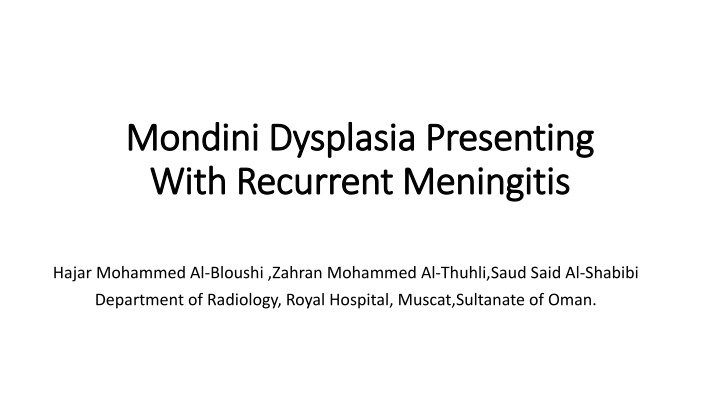
Recurrent Meningitis in Mondini Dysplasia: A Case Study
A 9-year-old girl presented with recurrent meningitis, leading to the diagnosis of Mondini dysplasia. This case study explores the association between congenital ear malformations like Mondini dysplasia and recurrent bacterial meningitis, highlighting the importance of detailed investigation in such cases to prevent morbidity and mortality.
Download Presentation

Please find below an Image/Link to download the presentation.
The content on the website is provided AS IS for your information and personal use only. It may not be sold, licensed, or shared on other websites without obtaining consent from the author. If you encounter any issues during the download, it is possible that the publisher has removed the file from their server.
You are allowed to download the files provided on this website for personal or commercial use, subject to the condition that they are used lawfully. All files are the property of their respective owners.
The content on the website is provided AS IS for your information and personal use only. It may not be sold, licensed, or shared on other websites without obtaining consent from the author.
E N D
Presentation Transcript
Mondini Dysplasia Presenting Mondini Dysplasia Presenting With Recurrent Meningitis With Recurrent Meningitis Hajar Mohammed Al-Bloushi ,Zahran Mohammed Al-Thuhli,Saud Said Al-Shabibi Department of Radiology, Royal Hospital, Muscat,Sultanate of Oman.
Case Report Case Report A 9-year-old girl was referred to the Royal Hospital with a history of recurrent meningitis. Cerebrospinal fluid (CSF) polymerase chain reaction (PCR) testing confirmed Streptococcus pneumoniae and Haemophilus influenzae as the causative pathogens. The first episode occurred at the age of 7, followed by a second episode in December 2023 and the most recent in January 2024. Clinical evaluation revealed sensorineural hearing loss and otitis media with effusion in the left ear. The patient was treated with a three-week course of intravenous antibiotics and was discharged after full recovery. Magnetic resonance imaging (MRI) of the brain (Figures 1a, b) demonstrated left-sided mastoiditis and abnormalities in the temporal bone anatomy. Specifically, the cochlea appeared cystic, with an absent modiolus (Figure 1b). There was no definitive basal turn of the cochlea, and the vestibular aqueduct was markedly dilated, measuring approximately 1.6 mm (Figure 1a). These findings strongly indicated a congenital inner ear malformation consistent with incomplete cochlear partition type 1 (ICP-1). To confirm the diagnosis, high-resolution computed tomography (HRCT) of the temporal bone was performed. The imaging revealed the characteristic "figure-8" appearance of the cochlea, confirming its cystic configuration and vestibular dilatation (Figures 2a, b). Additionally, the semicircular canals were found to be dysplastic and smaller than normal, further supporting the diagnosis of Mondini dysplasia.
(2) (1b) (1a) Figure 1a,b Figure 2: Computerized tomography of the temporal bone showing the dysmorphic cochlea in the left ear and the normal cochlear structure in the right ear.Cystic appearance of the cochlea and vestibular dilatation, giving the characteristic "figure-8" shape (red arrow). Figure 1 a: Axial T2-Wighted Image at the level of petrous bone demonstrate , high signal intensity with air fluid level in the left mastoid air cells (red arrow) . Dilated left vestibule (yellow arrow). Figure 1,b: coronal T2-Wighted Image at the level of temporal lobes , cystic dilatation of the left coclea (arrow head) .
Discussion Discussion Recurrent bacterial meningitis (RBM) is a serious condition that leads to significant morbidity and mortality, particularly when caused by congenital anatomical malformations such as Mondini dysplasia. RBM is typically caused by defects that allow communication between the cerebrospinal fluid (CSF) and the middle ear, leading to bacterial translocation into the CSF space. The most common pathogens in these cases are Streptococcus pneumoniae and Haemophilus influenzae, as seen in our patient s case [1, 2]. Mondini dysplasia is the most common congenital ear malformation associated with recurrent meningitis, resulting from a defective cochlea that allows for a fistula between the middle ear and the CSF space [1]. In our patient, recurrent meningitis episodes prompted detailed investigation, which led to the discovery of sensorineural hearing loss and abnormalities in the temporal bone, consistent with Mondini dysplasia. The cystic cochlea and vestibular dilatation observed on imaging are hallmark features of this condition, and the absence of the modiolus further supports the diagnosis of incomplete cochlear partition type 1 [3]. It is critical to evaluate children with recurrent meningitis for potential anatomical abnormalities, including Mondini dysplasia, especially when hearing loss is present. High-resolution CT of the temporal bone is the gold standard for diagnosing this condition, as it can reveal subtle malformations that may be missed with other imaging modalities [4, 5]. In our case, HRCT provided clear evidence of the cystic cochlea, vestibular dilatation, and dysplastic semicircular canals, confirming the diagnosis of Mondini dysplasia and explaining the patient s recurrent meningitis. Patients with Mondini dysplasia and recurrent meningitis often require surgical intervention to repair the CSF leak and prevent future episodes of infection. In cases where hearing loss is significant, hearing restoration methods such as cochlear implantation may be considered [6]. Our patient s management involved antibiotics to treat the acute episodes of meningitis, with close follow-up to monitor for any signs of further infections. Surgical consultation is recommended to assess the potential need for CSF leak repair, especially given the severity of the patient s recurrent meningitis.
References References 1.Ohlms LA, Edwards MS, Mason EO, Igarashi M, Alford BR, Smith RJH. Recurrent meningitis and Mondini dysplasia. Archives of Otolaryngology - Head and Neck Surgery [Internet]. 1990 May 1;116(5):608 12. Available from: https://doi.org/10.1001/archotol.1990.01870050108018. 2.McGill F, Solomon T. Meningitis in children. Lancet Neurol. 2021;20(5):320-329. 3.Wilkes MS, et al. Recurrent meningitis: Diagnosis and management. J Neurosurg Pediatr. 2020;25(3):296-303. 4.Schiffmacher J, et al. Imaging in recurrent meningitis: High-resolution CT of the temporal bones. Radiology. 2017;283(3):669-675. 5.Nussbaum J, et al. Imaging of temporal bone anomalies in recurrent meningitis. Neuroradiology. 2020;62(4):507-515. 6.Loomba R, et al. Surgical repair of temporal bone defects in pediatric patients. J Neurosurg Pediatr. 2018;22(1):33-40.
